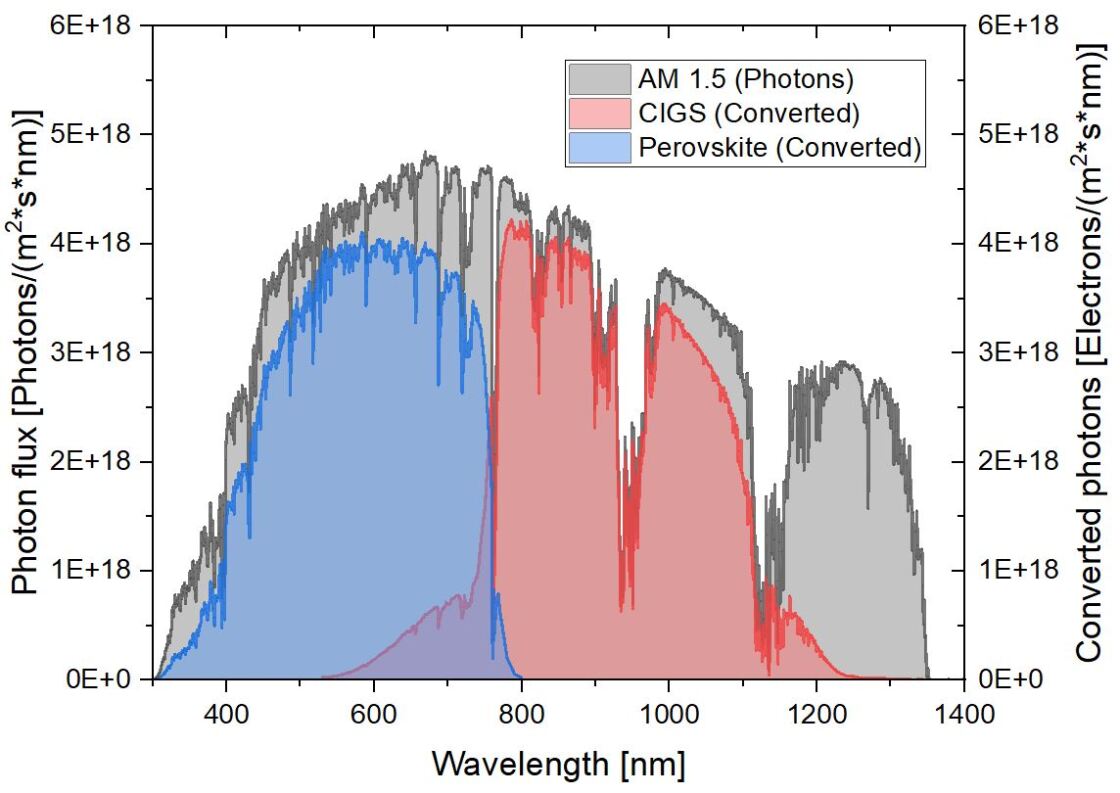PVcomB
Multi junction CIGS cells
Currently, the maximum efficiency of compound thin film photovoltaic devices is close to 24%, already approaching the technological limit. In order to further increase this value, a combination of solar cells with different spectral sensitivities, called multi-junction device, is necessary. These can convert a higher fraction of the energy of the solar spectrum into electric energy because each individual cell is optimized for a specific part of the solar spectrum.
An all thin-film approach to such a multi-junction device is a tandem where a perovskite solar cell (top cell) is stacked on top of a CIGS solar cell (bottom cell). In our preferred configuration the two cells are connected by a low-loss recombination junction exposing only the back contact of the bottom and the top contact of the top cell, respectively, to the external circuit (two terminal configuration).
Current research topics at PVcomB
Hole-selective transparent oxides for thin film tandem devices
In the perovskite solar cell the perovskite absorber is sandwiched in between selective contacts, the hole transport layer (HTL) and the electron transport layer (ETL). In a CIGS/pero tandem cell the HTL forms the p-type part of the recombination junction that connects top and bottom cell electrically and mechanically. Requirements for this hole-conducting material in this application are:
- A formation temperature of below 200°C, because it is deposited onto the CIGS device, which degrades at higher temperature
- A band gap exceeding 1.7 eV to make it transparent for long wavelength light
- Sufficient carrier density to form a low-loss recombination junction together with the n-type window material of the bottom cell
- Chemical compatibility with both perovskite and bottom cell window
- Mitigation of the roughness of the bottom cell for reliable perovskite growth and avoidance of shunts
- Long-term stability under the conditions of outdoor use of the PV device
Currently the preferred approach is a combination of Nickel oxide (sputtered or from a solution containing nano-particles) and a self assembled mono-layer (SAM). Research on this topic forms part of the Solmates project.
Preparation and analysis of complete CIGS/pero tandems
Complete tandem devices are prepared in collaboration with other groups at the Helmholtz-Zentrum Berlin and Humbold University Berlin and they are analyzed to verify and monitor the progress in the development of individual parts of the tandem stack. This collaboration currently holds the world record for CIGS/pero tandems with an efficiency of 24.6%. Initial outdoor testing of CIGS/pero tandems has started. A multiple linear regression approach to the interpretation of outdoor data had been developed for CIGS single junction modules and we hope to extend this approach to tandem devices. In collaboration with HTW Berlin we are investigating the options for monolithically interconnected tandem modules.
References
Ivona Kafedjiska, Igal Levine, Artem Musiienko, Natalia Maticiuc, Tobias Bertram, Amran Al-Ashouri, Christian A. Kaufmann, Steve Albrecht, Rutger Schlatmann, Iver Lauermann, Advanced Characterization and Optimization of NiOx:Cu-SAM Hole-Transporting Bi-Layer for 23.4% Efficient Monolithic Cu(In,Ga)Se2-Perovskite Tandem Solar Cell, Advanced Functional Materials (2023). https://doi.org/10.1002/adfm.202302924
Ivona Kafedjiska, Guillermo A. Farias-Basulto, Pablo Reyes-Figueroa, Tobias Bertram, Amran Al-Ashouri, Christian A. Kaufmann, Robert Wenisch, Steve Albrecht, Rutger Schlatmann, Iver Lauermann, Integration of rough RTP absorbers into CIGS-perovskite monolithic tandems by NiOx(:Cu)+SAM Hole-transporting Bi-layers, Solar Energy Materials and Solar Cells 254 (2023). https://doi.org/10.1016/j.solmat.2023.112248
Marko Jošt, Eike Köhnen, Amran Al-Ashouri, Tobias Bertram, Špela Tomšič, Artiom Magomedov, Ernestas Kasparavicius, Tim Kodalle, Benjamin Lipovšek, Vytautas Getautis, Rutger Schlatmann, Christian A. Kaufmann, Steve Albrecht, Marko Topič, Perovskite/CIGS Tandem Solar Cells: From Certified 24.2% toward 30% and Beyond, ACS Energy Letters 7 (2022)
Guillermo Farias Basulto, Thede Mehlhop, Nicolas Otto, Tobias Bertram, Christian A. Kaufmann, Iver Lauermann, Reiner Klenk, Stefan Gall, Emil List-Kratochvil, Rutger Schlatmann, Pushing the limits: CIGS/PSK tandem solar cells achieving 24.6% record efficiency, tandemPV international workshop, May 13-15, 2025, Hasselt, Belgium (invited talk)
Guillermo Farias-Basulto, Ivona Kafedjiska, Maximilian Riedel, Quiterie Emery, Marko Remec, Paolo Graniero, Mark Khenkin, Christian A. Kaufmann,
Iver Lauermann, Reiner Klenk, Steve Albrecht, Rutger Schlatmann, Carolin Ulbrich, Perovskite-CIGSe tandem solar cell: over one year of outdoor monitoring, PVSEC-35, Numazu, Japan, November 10-15, 2024
GA Farias-Basulto, C Ulbrich, R Schlatmann, R Klenk, Periodical evaluation of photovoltaic modules and diode parameter extraction method using multiple linear regression models, Japanese Journal of Applied Physics 62 (2023)
Christof Schultz, Guillermo Antonio Farias Basulto, Nicolas Otto, Janardan Dagar, Andreas Bartelt, Rutger Schlatmann, Eva Unger, Bert Stegemann, Laser-based monolithic series interconnection of two-terminal perovskite-CIGSe tandem solar cells: determination of the optimal scribe line properties, EPJ Photovoltaics 14 (2023). https://doi.org/10.1051/epjpv/2023007

